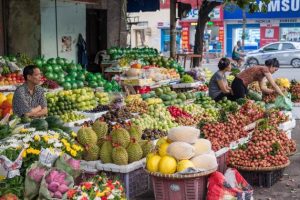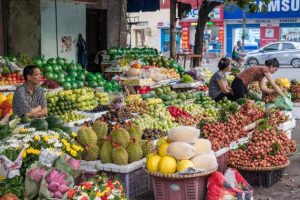What Local Food Challenges and Choices Across Vietnam Reveal About a Global Push for Food Systems Transformation
 21 April 2023
21 April 2023

Fruit stalls at a local market in Hanoi, Vietnam. Credit: Shutterstock.
By Tuyen Huynh
HANOI, Apr 20 2023 (IPS)
This month Nature spotlighted three insightful new studies chronicling food-related challenges from a global perspective. One presented worrisome new data on the global rise in the prevalence of diabetes, high blood pressure and liver disease, all linked to obesity. Another presented a new assessment revealing that half of the greenhouse emissions generated by food systems globally are caused by food waste. Finally, the third study found that food consumption could add “nearly 1 degree Celsius to warming by 2100,” with most of that attributed to global methane emissions from meat, dairy and rice production.
Studies like these are valuable for focusing attention on the need for a fundamental reset from farm to fork in the way food is produced and consumed around the world. But we also must recognize their limits.
Chiefly, that solutions to the problems they skillfully document will fail unless adapted to specific social, political and economic contexts on the ground.
As a fast-growing, rapidly urbanizing middle-income country that still has a large rural population, Vietnam is an ideal living laboratory for studying the essential role of local food environments in shaping solutions to global food challenges
We recently spent two years studying food systems across Northern Vietnam. Our work reveals how much food-related challenges can change even over relatively narrow distances—and how solutions must be tailored accordingly.
The contrasts we documented can be instructive for other countries as well. As a fast-growing, rapidly urbanizing middle-income country that still has a large rural population, Vietnam is an ideal living laboratory for studying the essential role of local food environments in shaping solutions to global food challenges.
In our work, we roamed the colorful, richly stocked open-air markets and modern retail outlets of urban Hanoi. We traveled just outside the city to study the food landscape in the populous peri-urban area of Dong Anh.
We visited the rural highlands of the Moc Chau district in Son La Province, where people rely on agriculture for their livelihoods. Along the way, we surveyed thousands of people to learn about where they purchased food and what they ate. Here are a few key lessons that emerged.
- Food-related issues are linked to both what you eat and where you eat it. With their bounty of choices and relatively high incomes, people in urban Hanoi tend to eat very diverse diets, including more meat, dairy and fish, than people in other areas in Northern Vietnam. It’s the opposite in rural Moc Chau: a dearth of food outlets and a reliance on subsistence farming leads to a narrower menu of options—and diets that are heavy in starchy staples. This difference produces a sharp contrast in food-related health problems. In rural areas, the issue is stunting and wasting in poorly fed children, which is three to four times higher than in urban or peri-urban areas. In urban areas, an abundance of food choices contributes to childhood obesity rates that are 6 to 10 times higher than in the other regions we studied.
- Problems are clear; solutions are complex—especially in local contexts: We know that addressing malnutrition requires improving food choices, but that also requires considering trade-offs that can be highly political. For example, there is evidence that consistent access to nutrient-dense meat, fish and dairy products can reduce malnutrition in low-income communities like those we studied in rural Vietnam. But a lack of these products in local diets is a key reason rural food systems in Vietnam produce much lower emissions than those in urban areas. The solution is two-fold. First, we must acknowledge the different realities of people in high-income regions globally who have an abundance of nutritious food choices and those in low-income regions who have few. Second, supporting efforts in low-income communities to adopt environmentally sustainable, climate-positive approaches to livestock production—while encouraging more modest consumption in wealthy regions–can capture their benefits in fighting malnutrition while mitigating risks.
- Promoting healthy diets requires probing local factors behind consumer behavior. Compared to other regions in Vietnam, a significantly higher percentage of rural consumers are relying on cheap and highly processed instant noodles to meet their dietary needs. But encouraging a shift to healthier diets requires engaging the broader constellation of local issues driving this choice. For example, economic policies that drive inflation can negatively affect household food budgets. Also, we found the neglect local road systems in rural areas we studied was a factor in limiting access to food stores and food selection relative to urban and peri-urban areas.
Two years ago, 51,000 people from 193 countries participated in the 2021 UN Food Systems Summit—with many likely to return for this summer’s eagerly anticipated follow-up.
They are committed to a transformation of a global food system many view as fundamentally broken. The latest scientific studies chronicling food-related impacts to human and planetary health—alongside the recent shocks to the global food system caused by Covid pandemic—certainly support this view.
Our work reveals that food system challenges vary considerably depending on where you live—and that developing effective solutions requires a focused effort to detect these differences. It means if we want to achieve a more sustainable food system transformation, we must think globally but act locally.
Tuyen Huynh is a leading food systems expert and senior researcher at the Alliance of Bioversity International and CIAT
